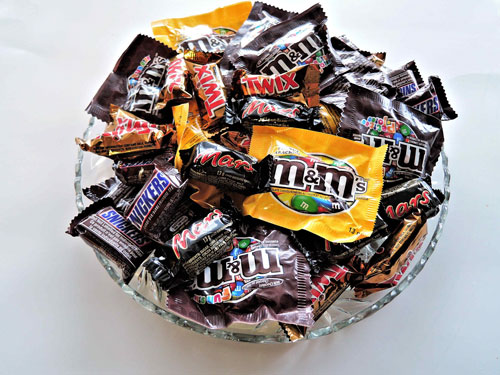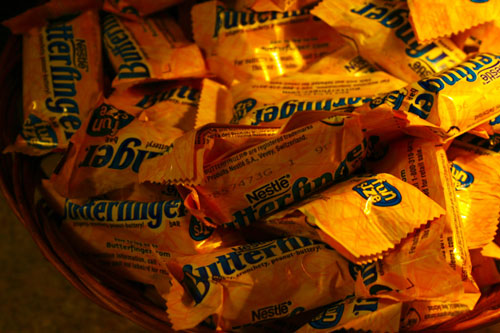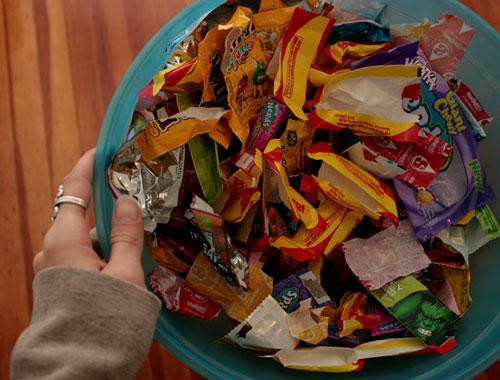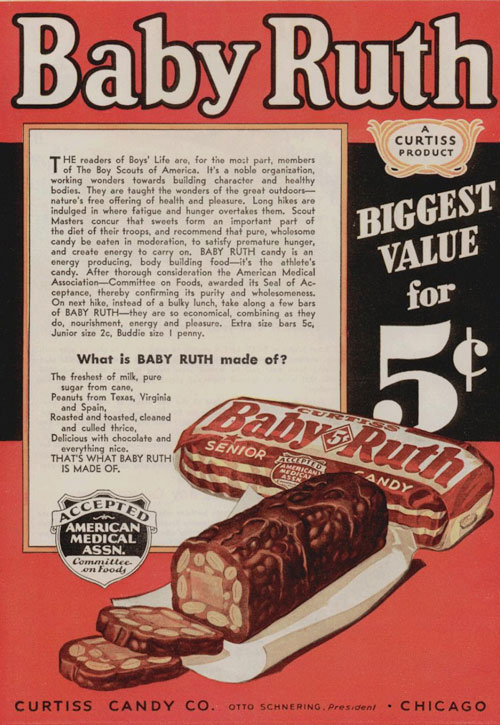Let's Overanalyze Fun
In honor of the 50th anniversary of the “Fun Size” candy bar, let’s highlight the time Mars tried to sue one of its largest competitors for using the term.
Sponsored By … You?
If you find weird or unusual topics like this super-fascinating, the best way to tell us is to give us a nod on Ko-Fi. It helps ensure that we can keep this machine moving, support outside writers, and bring on the tools to support our writing. (Also it’s heartening when someone chips in.)
We accept advertising, too! Check out this page to learn more.
17g
The weight, in ounces, of a “Fun Size” Snickers bar, which is about a third of a size of a standard Snickers bar, and has about 80 calories and 8.5 grams of sugar and 4 grams of fat. That’s right, roughly half of a Snickers bar is pure sugar and nearly a quarter of it is fat. Par for the course when it comes to candy, y’know.

A bowl of properly trademarked “Fun Size” candy. (Pixel1/Pixabay)
The term “Fun Size” is trademarked, there was a lawsuit over it, and Mars once owned the trademark to “Fun,” too
For being one of the most prominent companies in grocery stores around the world, a firm whose goods are frequently sold in checkout aisles and promoted during Super Bowls year in and year out, Mars, Inc. is a surprising enigma of a company.
Despite being one of the world’s largest companies (according to an estimate from earlier this year, it’s worth $35 billion, with a b), with a value worth more than a major wireless provider (Sprint has a market cap around $24 billion), Mars, Inc. has never been publicly traded, and its corporate headquarters is in a nondescript building outside of Washington, DC—an area that’s such a hotbed for big companies Amazon is rumored to be building its second headquarters nearby. The family-owned Mars, for decades, was very insular, to the point where it was a big deal when current chairman Stephen Badger, the great grandson of Frank Mars, decided it was time to start talking to the press earlier this year.
“We made a very conscious decision after quite a lot of discussion and disagreement over many years to fundamentally shift what had been a tradition for essentially 100 years, to pivot and engage the external world,” Badger told the Washington Business Journal.
Mars does a lot more stuff than candy, of course—it owns a huge chunk of the dog and cat food market and recently expanded its multi-billion-dollar veterinary care empire—but it’s understandable that you might think of Mars as a candy company first. After all, they make Snickers. And M&Ms. And Three Musketeers. And Twix. And Skittles.
These candies, famously, are among the best known varieties of “Fun Size” candy, a term that Mars came up with in 1968 for its miniaturized confections.
An ad, in Boys’ Life, featuring one of the earliest mentions of miniaturized, in this case “Junior,” candy bars. (Google Books)
Mars wasn’t first to this concept however—it was actually, technically, late. The Curtiss Candy Company, best known for Baby Ruth and Butterfinger candy bars, came up with a variant of this concept first, called the “Junior” candy bar. I can find references as far back as 1932, though a particularly prominent reference showed up in a full-page ad in the scouting magazine Boys’ Life dating to 1933, along with an even smaller “Buddie” size. These references long predate a claim in a legal document that Curtiss began selling “Junior” candy bars in the 1950s. (Yes, where we’re going, there are lawsuits. Strap in, sweet tooth.)
If Curtiss was selling miniature Baby Ruths in the 1930s, that means it also beat out Hershey, whose Miniatures have a design that’s perhaps more graceful and properly-proportioned than the loaf-like designs of their main competitors. Those came out in 1939, long before Mars even had its own take on this iconic idea.
Even though it was fashionably late, Mars came to define Halloween-season candy miniaturization. In the early 1960s, Mars began selling “Junior” variants of its popular candy bars, but then discontinued them in the late ’60s, deciding to come up with a slightly larger variant called “Fun Size.” The quick popularity of these morsels, particularly around Halloween, led many competitors to follow suit, including both Curtiss and its parent company, Standard Brands (which itself used “Fun Size” on its Planters Jumbo Block candy bar, making the entire concept of it being a “jumbo block” a complete misnomer).
Mars didn’t like this one bit, and after it registered a trademark for the term “Fun Size” in the state of Illinois in 1971, it sued Curtiss over the use of the term it came up with.
For those playing at home, here’s what happened: Mars “borrowed” the idea of individually packed candy bars from Curtiss, including the then-common name “Junior,” but then renamed the basic concept, and when Curtiss tried to do the exact same thing with “Fun Size,” Mars got mad and both parties went to court.
Initially, the case was a quick loss for Mars, as the defendants were quick to point out that a company on the West Coast had previously trademarked the term “fun” for candy-related uses way back in 1926.
“Defendants argue that since Mars could thus not establish proprietary rights in the word ‘fun’ for candy, nor in the unquestionably descriptive word ‘size,’ it certainly cannot be entitled to monopolize the combination,” an Illinois appellate court wrote upon denying a rehearing of Mars, Inc. v. Curtiss Candy Co. in 1972. (The appeals court found that the company could not claim that people specifically associated the term with its company.)
But Mars had an ace up its sleeve—it went to the West Coast firm mentioned in the appeals court ruling and literally purchased the trademark for “Fun” in an effort to prevent Butterfinger and Baby Ruth bars from having “Fun Size” equivalents. This purchase added a new wrench into the case, and Mars filed a new trademark infringement suit, while calling for a stay of the current case. That push led to a federal court decision in 1974, at which point the U.S. District Court of the Southern District of New York decided that the action couldn’t be denied outright, though the court stayed any action on the decision until the lawsuit had run its course.
“Defendants ask this Court to exercise its discretion in this case,” the court case stated. “They contend that plaintiff purchased the federally registered trademark of ‘Fun’ solely to get a second day in court and that, in reality, the two actions are one and the same.”

Trademark infringement. (chaparral/Flickr)
As these are nearly 50-year-old court cases that don’t appear to have gained any notice in the media at the time, the trail grows cold after the 1974 decision, but it’s relatively easy to deduce what happened after: Mars was unable to prevent Curtiss, Standard, or the candy bars’ later corporate parent, Nestlé, from using the term “Fun Size” to promote their individually-wrapped candy bars, based on the fact that you can purchase “Fun Size” Butterfinger and Baby Ruth bars pretty much anywhere.
To this day, Mars has a trademark on “Fun Size,” though it let its trademark on “Fun” expire in the ’90s. Certainly, it’s a bizarre state of affairs that there was an actual lawsuit over the basically generic term “Fun Size,” but one has to wonder what might have happened had the candy industry just allowed their competitors to share the term.
Fact is, when it lands at the bottom of the pillowcase you turned into a candy bag, everyone wins anyway.
“The main difference between the two NESTLÉ® BUTTERFINGER® varieties is apparent as soon as you open the packages: The Fun Size bars do not travel well. Every one I opened was coated with a fine layer of orange detritus. The standard size bars, by contrast, emerged from their wrapping pristine.”
— Writer Caity Weaver, a Gawker alum currently at The New York Times, explaining one of the weak points of the “Fun Size” Butterfinger candy bar in an in-depth review of a number of major variants of candy bar in a classic 2014 Gawker piece.

So. Many. Wrappers. (Amy Messere/Flickr)
One big problem that’s never discussed with all this Halloween candy: We can’t recycle the dang wrappers
For pieces of candy that are generally, on average, less than an ounce in size, we sure cover them in a lot of paper, plastic, and other materials. And there are often hundreds of pieces of candy in a single bag after a round of trick-or-treating.
As I noted in an issue where I discussed the state of the napkin (I know, real exciting topics in this newsletter), materials with contaminants on them, particularly food, generally aren’t easily recyclable. And this is particularly an issue with many food wrappers, which largely aren’t made with materials that easily biodegrade. This is a problem for food products in general, but is particularly bad for packaging made with mixed materials—particularly anything that combines foil and plastic, which is perhaps the most notorious combination of materials recyclers have to deal with. (Two words: Sauce packets, which Mother Nature Network recently called “the new straw.”)
Combine all that drama with the fact that the average kid’s pile of candy is often a mishmash of paper, plastic, foil, and other materials (is nougat recyclable?), and you’ve got a bit of a recycling mess on your hands. The site Earth911 put it this way:
Because plastic bottles can be recovered easily and economically, and there’s a healthy end-use market for their recovered materials, waste management facilities have an incentive for their collection and processing. However, candy wrappers are usually made up of mixed materials, making the recovery of useful materials difficult and expensive.
On the plus side, Mars, the company that literally purchased the trademark to “Fun” to try to prevent another company from having fun, actually put a lot of work into this issue a couple of years back. Back in 2010, a manager at a Mars factory in the Netherlands asked the head of a company that focuses on biopolymers if they could produce a plastic wrapper, made from plants, that was as good as the wrapper they were currently using. The short answer was yes, though there was also a long answer, noted Thijs Rodenburg, the head of Rodenburg Biopolymers.
“We told him we could do all that,” Rodenburg told Plastic Today. “But then we had to do it.”
It was not an easy process—the plastic was derived from wastewater created in potato production, which shoul d tell you everything you need to know about biopolymers—but by 2015, Mars had put its Snickers bars into biodegradable packaging in the European market, and the next year, the efforts to put their candy bars in biopolymers won an award. It’s part of a broader plan by Mars to go fully recyclable, reusable, or compostable by 2015—a plan that it claims it’s 90 percent of the way on, and extends to a lot of different lines of goods. The company has to worry about M&M’s just as much as they do about Uncle Ben’s rice, Wrigley’s chewing gum, and Iams dog food.
The process of making candy wrappers recyclable isn’t going to happen tomorrow, but Mars is further along than many of its competitors. (Greenpeace’s Canada arm recently called out both Nestlé and Hershey for the waste they create.) It’s certainly not a fun-sized effort, but it might eventually make Halloween candy a little less environmentally problematic.
“Quickly, the pride of being the best house on the block gives way to shame, and the excitement of having the best haul buckles into boredom. When kids return home with the big Snickers or 3 Musketeers, what then? Who cares. They’ve done all this before.”
— Ian Bogost, a contributing editor to The Atlantic, making the case that full-sized candy bars, while often considered major wins for kids on Halloween, go against the spirit of the holiday, while the “Fun Size” candy bars highlight a certain novelty that generally isn’t experienced throughout the year. “Fun-size candy bars are fun for this reason,” he explains. “They offer a different way of acquiring, holding, and tasting familiar candy-bar products.”
Last year, a wise soul with a great sense of humor named Adam Padilla came up with the scariest Halloween-related thing I’ve ever seen. With the help of Photoshop, he whipped together tiny bags of Dole salad in “Fun Size” pouches, implying that the one thing missing from our neighborhood sampling endeavor is a little bit of roughage.
And fittingly, Dole responded in a way that fits snugly within the history of “Fun Size” packaging. In a tweet, the company complimented Padilla’s work, came up with its own photoshop of “Fun Size” fruits and vegetables, but then implied that the artist was infringing on their brand. The response showed Dole’s claws for a brief moment, but ultimately put them away.
“Normally, we would insist that you take your images down or else I and our more formal and scary hired-gun lawyers would come and take all your candy away,” wrote Dole Vice President and Division General Counsel Richard Jacobs. “In the ‘treat’ spirit of the season, though, we just ask that you please contact us in advance if you wish to use any of our trademarks in the future.”
(You could cut a pineapple with those claws!)
Perhaps, in its own weird way, “Fun Size” packaging brings out some scary parts of corporate America. I mean, considering the holiday, it’s fitting, right?
:format(jpeg)/2018/10/tedium103018.gif)
/2018/10/tedium103018.gif)



/uploads/ernie_crop.jpg)